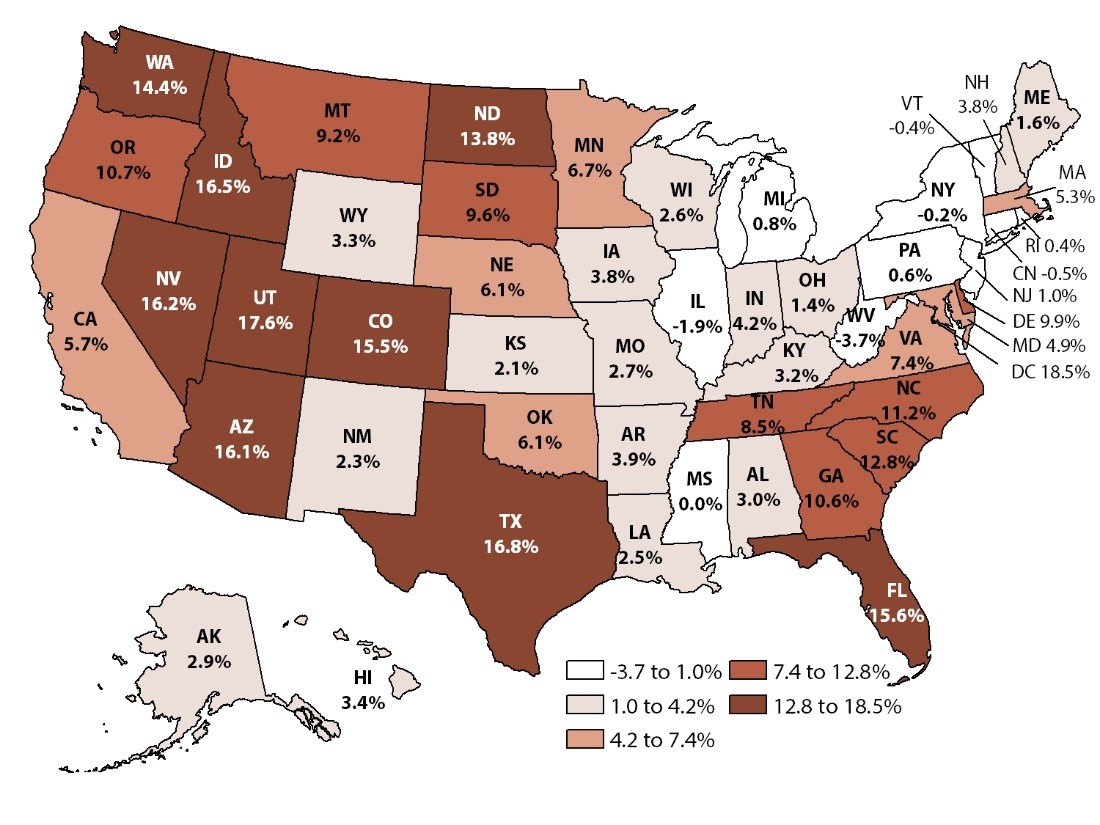Blog Post
Insight: New 2020 Census Bureau Estimates
By Mallory Bateman
Note: The opinions expressed are those of the author alone and do not reflect an institutional position of the Gardner Institute. We hope the opinions shared contribute to the marketplace of ideas and help people as they formulate their own INFORMED DECISIONS™.
Dec 28, 2020 – On December 22, the Census Bureau Population Division released their 2020 estimates for states and the nation. These estimates indicate that Utah’s population increased from 2,763,885 at the 2010 Census to 3,249,879 on July 1, 2020. Our overall growth rate across this period was the highest of any state at 17.6%.
Growth Rate from April 1, 2010 to July 1, 2020
Source: U.S. Census Bureau, Population Division
If we assume a linear growth path, we can get an estimate for April 1, 2020 from the new Census Bureau data. This framing provides a population of 3,238,255 in Utah on Census Day. This translates to slower growth (474,370 new Utahns or 17.2% growth) than in the past several decades. Analysis of historical decennial data indicated that both the 1990s and 2000s added more than 500,000 residents each. This growth resulted in a 29.6% growth rate between 1990 and 2000, and 23.8% between 2000 and 2010.
The South (driven mainly by Texas, Florida, and Georgia) and the West were home to the most growth this decade. Nationwide, the population grew by 6.7%, which equates to over 20 million people. Between the 2000 and 2010 decennial censuses, the national growth rate was 9.7%. With an aging population and decreasing migration throughout the decade (and since the 1970s), this relatively low growth rate is not surprising.
Year-over-year change in these estimates indicates a 1.5% increase in Utah’s population between 2019 and 2020. This pace of growth is consistent with annual growth rates throughout the decade, which have ranged from 1.4% to 2.0%. Nationwide, the population grew by only 0.4% between 2019 and 2020. The Northeast had a small decline, the Midwest did not change, and the South and West increased slightly.
How does this compare to the Utah Population Committee (UPC) estimates for 2020? The UPC estimates give Utah a slightly higher growth rate at 1.64%, putting the July 1, 2020 population at 3,273,000. Using the same framing we did with the Census Bureau estimates, the April 1, 2020 estimate would be 3,259, 793. That results in a difference of about 21,500 compared to the Census Bureau estimates, and puts growth since the 2010 Census at 495,908. These higher values translate to an increase in the decadal growth rate from 17.7% to 17.9%.
Both the UPC and Census Bureau estimates are a July 1 headcount, use the 2010 Census as a baseline, and turn to vital statistics and administrative data to inform net migration and natural increase. Neither set of estimates considers or uses the 2020 Census results. However, both provide a benchmark for comparison with state enumerations. Comparisons of the decennial counts and the estimates will be analyzed to assess the estimates’ accuracy throughout the decade. Nationally, the Demographic Analysis Estimates provide a range of suitable April 1, 2020 estimates for the 2020 Census count using similar data sources.
2020 Census results will begin to be released soon. State numbers for apportionment purposes come first, followed by more detailed data for redistricting (to be released in the spring). These counts will provide insights into the nation’s population on April 1, 2020, and create the baseline for the next decade’s estimate products.
Mallory Bateman is a senior research associate at the Kem C. Gardner Policy Institute.







